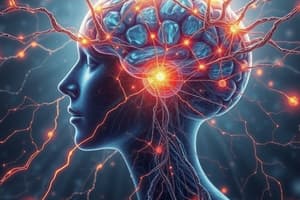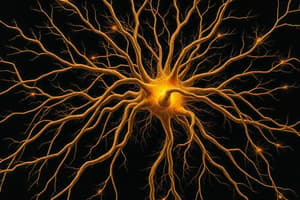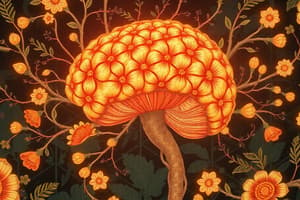Podcast
Questions and Answers
What is a neuron?
What is a neuron?
A neuron is a specialized cell of the nervous system that receives and transmits messages.
What is the role of glial cells?
What is the role of glial cells?
Glial cells remove dead neurons and waste products, nourish and insulate neurons, and aid in neural transmission.
The ______ are root-like structures that receive impulses from other neurons.
The ______ are root-like structures that receive impulses from other neurons.
dendrites
What does myelin do?
What does myelin do?
What are afferent neurons?
What are afferent neurons?
What does the term 'action potential' refer to?
What does the term 'action potential' refer to?
The refractory period makes a neuron more sensitive to incoming messages.
The refractory period makes a neuron more sensitive to incoming messages.
Which neurotransmitter is involved in the perception of pleasure?
Which neurotransmitter is involved in the perception of pleasure?
What does the autonomic nervous system regulate?
What does the autonomic nervous system regulate?
Match the following neurotransmitters with their effects:
Match the following neurotransmitters with their effects:
Flashcards are hidden until you start studying
Study Notes
Biological Basis of Human Behavior
- Human behavior is influenced by both nature (genetic inheritance) and nurture (environmental factors).
- The nervous system and endocrine system serve distinct functions, with the nervous system primarily facilitating rapid communication through electrical signals, while the endocrine system manages longer-lasting regulatory functions through hormones.
Neurons and Glial Cells
- Neurons are specialized cells that receive and transmit neural messages.
- Glial cells support neurons by removing dead cells, nourishing them, insulating axons, and aiding in neural transmission.
Parts of Neurons
- Dendrites are tree-like structures that receive incoming messages from other neurons.
- Axons, which are long and slender, transmit impulses to other neurons via axon terminals.
- Myelin is a fatty substance that insulates axons, enhancing the speed of neural impulse transmission.
Neural Impulse
- Afferent neurons (sensory neurons) carry messages from sensory receptors to the central nervous system (CNS).
- Efferent neurons (motor neurons) transmit messages from the CNS to muscles and glands.
- Neural impulses are the electrochemical discharges of neurons, marked by various states:
- Polarization prepares a neuron for firing by creating a negative internal charge.
- Resting potential is typically about -70 millivolts.
- Depolarization reduces the resting potential toward zero.
- Action potential is the electrical impulse that propagates along an axon.
Synapse and Signal Transmission
- A synapse is the junction between axon terminals of one neuron and dendrites of another.
- The all-or-none principle states that a neuron fires with consistent strength when triggered.
- The refractory period is a phase after firing when a neuron is less responsive to incoming signals.
- Neurotransmitters are chemicals that facilitate communication between neurons.
- Receptor sites on receiving neurons are specifically designed to bind with neurotransmitters.
Key Neurotransmitters
- Acetylcholine (ACh): essential for muscle movement, memory, and cognition.
- Dopamine: linked to pleasure perception, voluntary movement, learning, and implicated in disorders like Parkinson's and schizophrenia.
- Norepinephrine: related to stress responses, with links to depression.
- Serotonin: influences emotional states and sleep; deficiencies are associated with various mental health issues.
- Gamma-aminobutyric acid (GABA): an inhibitory neurotransmitter that helps alleviate anxiety.
- Endorphins: natural pain relievers in the brain, similar to morphine.
Nervous System Overview
-
The nervous system is divided into:
- Peripheral Nervous System (PNS): includes somatic and autonomic nervous systems.
- Somatic system conveys messages to and from the CNS about external stimuli.
- Autonomic system regulates involuntary functions (heart rate, respiration).
- Sympathetic division prepares the body for 'fight or flight.'
- Parasympathetic division conserves energy and restores the body post-stress.
- Peripheral Nervous System (PNS): includes somatic and autonomic nervous systems.
-
Central Nervous System (CNS) consists of:
- Spinal Cord: transmits signals between the brain and the rest of the body.
- Spinal Reflex: response involving a direct pathway from sensory to motor neurons.
- Gray Matter: consists of neuron cell bodies involved in reflex actions.
- White Matter: contains axon bundles for communication between brain and body.
Brain and Cerebral Cortex
- The cerebrum is the largest part of the brain and consists of two hemispheres.
- The cerebral cortex is a wrinkled outer layer of the brain, involved in many higher brain functions.
Studying That Suits You
Use AI to generate personalized quizzes and flashcards to suit your learning preferences.




